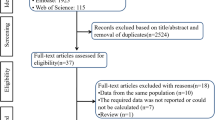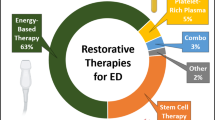Abstract
We searched for population-based cross-sectional studies, cohort studies and randomized controlled trials (RCTs) on erectile dysfunction (ED) through Medline, PubMed, PsychInfo and scanned though reference lists. Studies that did not include adjusted odds ratios (OR) of physical activity were excluded. Seven cross-sectional studies were suitable for meta-analysis, and the results from one cross-section study, two cohort studies and one RCT were summarized. Pooling the ORs using random effects models, we derived summary estimate for adjusted OR of physical activity in those with ED compared with those without ED, which was 0.53 (0.31, 0.91). Moderate and high physical activities were associated with a lower risk of ED, with ORs at 0.63 (0.43, 0.93) and 0.42 (0.22, 0.82), respectively. Funnel plot by visual inspection, and Begg's test and Egger's test did not detect significant publication bias. Sensitivity analyses revealed that the summary estimate from the random effects model was robust to changes in study sample size and level of statistical adjustment, but not so robust to changes in ED definition, although the summary estimate for each ED definition did not differ significantly. Although causality cannot be demonstrated from cross-sectional studies, the apparent ‘protective’ effect of physical activity on ED should be further investigated using large-scale cohort studies or RCTs.
This is a preview of subscription content, access via your institution
Access options
Subscribe to this journal
Receive 8 print issues and online access
$259.00 per year
only $32.38 per issue
Buy this article
- Purchase on Springer Link
- Instant access to full article PDF
Prices may be subject to local taxes which are calculated during checkout








Similar content being viewed by others
Abbreviations
- ED:
-
erectile dysfunction
- IIEF:
-
International Index of Erectile Function
- HPFS:
-
Health Professionals Follow-up Study
- MMAS:
-
Massachusetts Male Aging Study
- CI:
-
confidence interval
- RCT:
-
randomized controlled trials
References
Thompson IM, Tangen CM, Goodman PJ, Probstfield JL, Moinpour CM, Coltman CA . Erectile dysfunction and subsequent cardiovascular disease. JAMA 2005; 294 (23): 2996–3002.
Thomas GN, Tomlinson B, Abdullah AS, Yeung VT, Chan JC, Wong KS . Association of erectile dysfunction with cardiovascular risk factors and increasing existing vascular disease in male Chinese type 2 diabetic patients. Diabetes Care 2005; 28 (8): 2051–2053.
Le NA . Inflammation, oxidative stress, and atherosclerosis. Curr Opin Lipidol 2004; 15 (2): 227–229.
Prins J, Blanker MH, Bohnen AM, Thomas S, Bosch JL . Prevalence of erectile dysfunction: a systematic review of population-based studies. Int J Impot Res 2002; 14 (6): 422–432.
Shaeer KZ, Osegbe DN, Siddiqui SH, Razzaque A, Glasser DB, Jaguste V . Prevalence of erectile dysfunction and its correlates among men attending primary care clinics in three countries: Pakistan, Egypt, and Nigeria. Int J Impot Res 2003; 15 (Suppl 1): S8–S14.
Moreira Jr ED, Lisboa Lobo CF, Villa M, Nicolosi A, Glasser DB . Prevalence and correlates of erectile dysfunction in Salvador, northeastern Brazil: a population-based study. Int J Impot Res 2002; 14 (Suppl 2): S3–S9.
Akkus E, Kadioglu A, Esen A, Doran S, Ergen A, Anafarta K et al. Prevalence and correlates of erectile dysfunction in Turkey: a population-based study. Eur Urol 2002; 41 (3): 298–304.
Bai Q, Xu QQ, Jiang H, Zhang WL, Wang XH, Zhu JC . Prevalence and risk factors of erectile dysfunction in three cities of China: a community-based study. Asian J Androl 2004; 6 (4): 343–348.
Nicolosi A, Moreira Jr ED, Shirai M, Bin Mohd Tambi MI, Glasser DB . Epidemiology of erectile dysfunction in four countries: cross-national study of the prevalence and correlates of erectile dysfunction. Urology 2003; 61 (1): 201–206.
Millett C, Wen LM, Rissel C, Smith A, Richters J, Grulich A et al. Smoking and erectile dysfunction: findings from a representative sample of Australian men. Tob Control 2006; 15 (2): 136–139.
Parazzini F, Menchini Fabris F, Bortolotti A, Calabro A, Chatenoud L, Colli E et al. Frequency and determinants of erectile dysfunction in Italy. Eur Urol 2000; 37 (1): 43–49.
Mak R, De Backer G, Kornitzer M, De Meyer JM . Prevalence and correlates of erectile dysfunction in a population-based study in Belgium. Eur Urol 2002; 41 (2): 132–138.
Fedele D, Bortolotti A, Coscelli C, Santeusanio F, Chatenoud L, Colli E et al. Erectile dysfunction in type 1 and type 2 diabetics in Italy. On behalf of Gruppo Italiano Studio Deficit Erettile nei Diabetici. Int J Epidemiol 2000; 29 (3): 524–531.
Cho BL, Kim YS, Choi YS, Hong MH, Seo HG, Lee SY et al. Prevalence and risk factors for erectile dysfunction in primary care: results of a Korean study. Int J Impot Res 2003; 15 (5): 323–328.
Terai A, Ichioka K, Matsui Y, Yoshimura K . Association of lower urinary tract symptoms with erectile dysfunction in Japanese men. Urology 2004; 64 (1): 132–136.
Tan JK, Hong CY, Png DJ, Liew LC, Wong ML . Erectile dysfunction in Singapore: prevalence and its associated factors—a population-based study. Singapore Med J 2003; 44 (1): 20–26.
Bacon CG, Mittleman MA, Kawachi I, Giovannucci E, Glasser DB, Rimm EB . Sexual function in men older than 50 years of age: results from the health professionals follow-up study. Ann Intern Med 2003; 139 (3): 161–168.
Bacon CG, Mittleman MA, Kawachi I, Giovannucci E, Glasser DB, Rimm EB . A prospective study of risk factors for erectile dysfunction. J Urol 2006; 176 (1): 217–221.
Feldman HA, Johannes CB, Derby CA, Kleinman KP, Mohr BA, Araujo AB et al. Erectile dysfunction and coronary risk factors: prospective results from the Massachusetts male aging study. Prev Med 2000; 30 (4): 328–338.
Esposito K, Giugliano F, Di Palo C, Giugliano G, Marfella R, D'Andrea F et al. Effect of lifestyle changes on erectile dysfunction in obese men: a randomized controlled trial. JAMA 2004; 291 (24): 2978–2984.
Author information
Authors and Affiliations
Corresponding author
Rights and permissions
About this article
Cite this article
Cheng, J., Ng, E., Ko, J. et al. Physical activity and erectile dysfunction: meta-analysis of population-based studies. Int J Impot Res 19, 245–252 (2007). https://doi.org/10.1038/sj.ijir.3901521
Received:
Revised:
Accepted:
Published:
Issue Date:
DOI: https://doi.org/10.1038/sj.ijir.3901521
Keywords
This article is cited by
-
Prevalence and associated factors of moderate to severe erectile dysfunction among adult men in Malaysia
Scientific Reports (2023)
-
People smoke for nicotine, but lose sexual and reproductive health for tar: a narrative review on the effect of cigarette smoking on male sexuality and reproduction
Journal of Endocrinological Investigation (2020)
-
Sport and male sexuality
Journal of Endocrinological Investigation (2017)
-
Erectile dysfunction
Nature Reviews Disease Primers (2016)
-
Sexualität bei Übergewicht und Adipositas
Wiener Medizinische Wochenschrift (2016)



